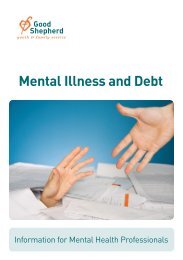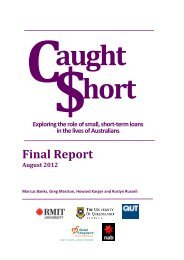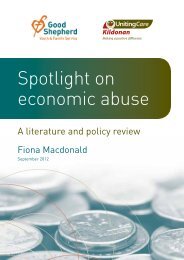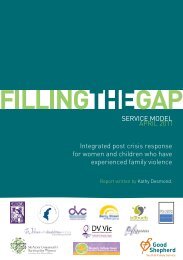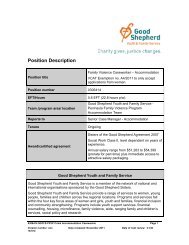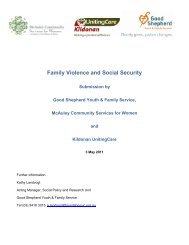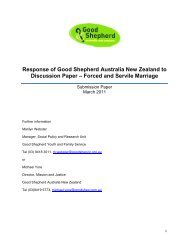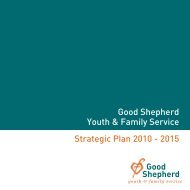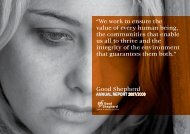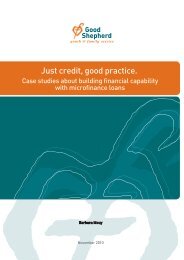Spotlight on economic abuse - Good Shepherd Youth & Family ...
Spotlight on economic abuse - Good Shepherd Youth & Family ...
Spotlight on economic abuse - Good Shepherd Youth & Family ...
Create successful ePaper yourself
Turn your PDF publications into a flip-book with our unique Google optimized e-Paper software.
The ALRC recommended a host of changes to Department of Human Services practices to<br />
address c<strong>on</strong>cerns for improving the agency identificati<strong>on</strong> of and resp<strong>on</strong>se to family violence<br />
and safety and decreasing opportunities for <strong>on</strong>going <strong>abuse</strong> and these are listed in full in<br />
Appendix A of this report. Notably, in its c<strong>on</strong>siderati<strong>on</strong>s the ALRC (2011c, p. 131) included<br />
financial security as an aspect of safety.<br />
The child support system also interacts with the system of family assistance payments to<br />
parents such that parents are obliged to seek child support payments to be eligible to<br />
receive <strong>Family</strong> Tax Benefit. This means that a woman who does not seek child support from<br />
an ex-partner due to fear of violence could be doubly disadvantaged by being denied <strong>Family</strong><br />
Tax Benefit. There is a family violence exempti<strong>on</strong> enabling victims of family violence to opt<br />
out of obtaining child support payments where this would place them at risk without a<br />
c<strong>on</strong>sequent reducti<strong>on</strong> to their <strong>Family</strong> Tax Benefit Part A payments and the recent ALRC<br />
review recommended that this protective measure be strengthened through a number of<br />
changes to the administrative <strong>Family</strong> Assistance Guide (ALRC 2011c). At the time of writing<br />
it is not known what acti<strong>on</strong>s have been taken in resp<strong>on</strong>se to these recommendati<strong>on</strong>s by the<br />
Comm<strong>on</strong>wealth Department of Human Services which has resp<strong>on</strong>sibility for this area.<br />
Homelessness<br />
Access to safe and affordable housing is a crucial issue for women escaping domestic and<br />
family violence and while homelessness c<strong>on</strong>tinues have major negative impacts there have<br />
been some recent policy developments which have the objective of addressing these issues.<br />
At the same time the broader c<strong>on</strong>text is <strong>on</strong>e of chr<strong>on</strong>ic shortage of both emergency<br />
accommodati<strong>on</strong> and affordable housing in Australia.<br />
Policies for addressing homelessness due to domestic and family violence are mostly<br />
reactive or tertiary interventi<strong>on</strong>s as there is usually no awareness of the problem until a<br />
woman leaves her home and seeks assistance (MacKenzie & Chamberlain 2003; Tually<br />
2008). So, other than broad strategies for preventing domestic violence it has been<br />
c<strong>on</strong>sidered difficult to identify measures to prevent homelessness. However, in recent years<br />
there have been some new initiatives which suggest better sec<strong>on</strong>dary interventi<strong>on</strong>s that may<br />
increase the possibility for more women to remain in their homes safely after the perpetrator<br />
of violence has left.<br />
The Comm<strong>on</strong>wealth’s White Paper <strong>on</strong> Homelessness, The Road Home (Australia 2008),<br />
identified a need for expanded models of integrated support to enable women and children<br />
experiencing domestic and family violence to remain safely in their own homes. New targets<br />
for the Comm<strong>on</strong>wealth and states in regard to reducing homelessness of women and<br />
children were also set under the Nati<strong>on</strong>al Affordable Housing Agreement which is<br />
underpinned by the Nati<strong>on</strong>al Partnership Agreement <strong>on</strong> Homelessness between the<br />
Comm<strong>on</strong>wealth, states and territories, which has recently been reviewed (COAG 2012,<br />
accessed 19 July 2012 at ).<br />
Prior to the 2008 nati<strong>on</strong>al agreement, some states and territories had introduced ‘safe at<br />
home’ models of resp<strong>on</strong>ses to homelessness precipitated by domestic and family violence<br />
and the White Paper identified this type of strategy as an area for development (Australia<br />
2008, p. 330). This model relies <strong>on</strong> an integrated resp<strong>on</strong>se to family violence by the criminal<br />
justice and health and community services sectors. The model allows women and their<br />
children to stay in the home by removing the perpetrator and in this it is a resp<strong>on</strong>se which<br />
assumes perpetrators should be held accountable for their acti<strong>on</strong>s (Tually et al 2008). This<br />
model can provide women and children with stability and enable them to maintain social<br />
support and to experience less disrupti<strong>on</strong> to their participati<strong>on</strong> in employment and educati<strong>on</strong>.<br />
It is supported by legal arrangements in all Australian states and territories which provide for<br />
33



